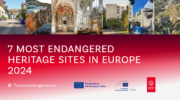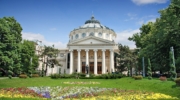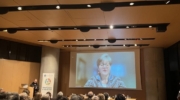Evaluation meeting of 7 Most Endangered programme takes place in The Hague
Representatives from Europa Nostra, the European Investment Bank Institute (EIBI) and the Council of Europe Development Bank (CEB) met on 15 November in The Hague to take stock of their flagship programme the 7 Most Endangered, which was launched in 2013, and to discuss the way forward. Delegates from several organisations that nominated heritage sites for the first three editions of the 7 Most Endangered programme contributed to the meeting. A total of 39 people were in attendance, including Henry von Blumenthal, Deputy Dean of the EIBI. The insightful presentations made by heritage and technical experts were followed by rounds of fruitful discussions moderated by Europa Nostra’s Board Member Guy Clausse, Executive Vice-President John Sell and Vice-President Piet Jaspaert, respectively.
The first session concentrated on the lessons learned from various projects selected in 2013 and 2014. Peter Bond, Technical Consultant provided by the EIBI, gave an update on the Monastery and Church of Jesus in Setúbal in Portugal (2013) and the Wooden Churches in Southern Transylvania and Northern Oltenia in Romania (2014). Richard Deeley, on behalf of the EIBI, presented the latest developments on St. George’s Armenian Church in Mardin in Turkey (2013) and the Synagogue in Subotica in Serbia (2014). Pedro Ponce de León, Technical Consultant provided by the CEB, gave an insight into the Roman Amphitheatre in Durrës in Albania (2013) and the Neighbourhoods of Dolcho and Apozari in Kastoria in Greece (2014).
The second session focused on the lessons drawn from several projects included in the 2016 list of 7 Most Endangered. Gaianè Casnati, Director of the Centre of Studies and Documentation of Armenian Culture in Italy, and Mario Aymerich, on behalf of the EIBI, spoke about the Archaeological Site of Ererouyk and village of Ani Pemza in Armenia. Tapani Mustonen, Chairman of Europa Nostra Finland, presented the Helsinki-Malmi Airport in Finland, one of the few cases in which the EIBI was not involved. Mario Aymerich provided an update on Patarei Sea Fortress in Tallinn in Estonia. Finally, Campbell Thompson, on behalf of CEB, outlined the main results and recommendations of the technical report produced on the Convent of St. Anthony of Padua in Extremadura in Spain.
The third session was dedicated to the overall evaluation of the 7 Most Endangered programme and the way forward.
“There is general agreement that the 7 Most Endangered programme has run rather well over its existence of 5 years. A total of 22 projects located in 15 countries were selected from of a total number of some 85 nominations. The measures taken thereafter aimed primarily at lifting the visibility of lesser known or forgotten heritage projects and at simultaneously increasing their credibility (through the preparation of a technical report, typically including a rescue plan proposal), while drawing on both European and local expertise,” stated Guy Clausse, Board Member of Europa Nostra.
“When combined with a strong involvement at the local and national levels, the results turned out to be quite impressive and significantly contributed to a number of endangered sites and monuments moving out of the initial ‘danger zone’. However, such results could not be obtained in all cases; also, the majority of positive results only accrued over a longer period of time than initially expected, and required more support beyond the original report than envisaged at the outset. In sum, the approach has worked, but there is scope for fine-tuning which should be explored,” he noted.
Guy Clausse drew attention to the key issues raised in the document ‘Towards a review of the approach of the 7 Most Endangered programme’, which he prepared on the basis of the results of the evaluation factsheets of the listed sites, which were recently produced by the technical consultants provided by the EIBI and the CEB. Among the main issues addressed is the need to find sustainable solutions for the sites, the role of the nominators, the position of the owners and the roles of Europa Nostra and the EIBI during the expert missions and in the report writing.
The presentation of the outcomes of the evaluation questionnaire sent to the nominators of all the shortlisted and listed sites in 2013, 2014 and 2016 set the stage for a fruitful exchange of views with the delegates. The questionnaire received 25 replies which corresponds to 67.5 % of the nominators. Piet Jaspaert, Vice-President of Europa Nostra, emphasised the high percentage of replies and noted that the responses are almost all good and/or excellent.
For additional information about the evaluation meeting of the 7 Most Endangered programme, please read the related minutes drafted by Europa Nostra’s Board Member Guy Clausse.
The topic of the 7 Most Endangered programme and of the evaluation meeting was also on the agenda of both the Europa Nostra’s Council and Board meetings held on 16-17 November in The Hague. Overall appreciation for the initiative was voiced.
The 7 Most Endangered programme is celebrating its 5th anniversary in 2018, during the European Year of Cultural Heritage. To mark the occasion, a Conference will be organised by Europa Nostra together with the European Investment Bank Institute and local partners. The European heritage sites shortlisted for the 7 Most Endangered programme 2018 will be announced in mid-January and the final list will be made public in mid-March.








